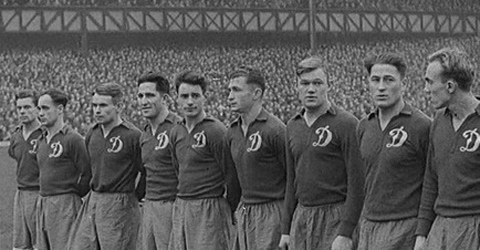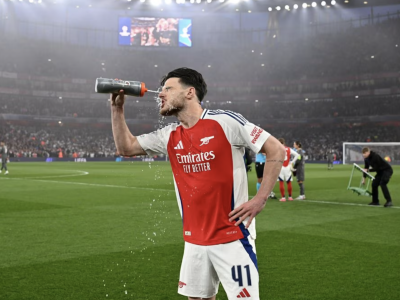After the long gap between the end of a football season and the start of new one (particularly in a year when the home nations are not involved in a major international tournament), it usually feels like relief when the season kicks off again, even though the earliest fixtures involve mere friendlies. However, though such so called ‘uncompetitive’ fixtures are generally considered to be meaningless, not all lack the competitive spirit and some have even had a historical significance of their own. One of the earliest regular friendly fixtures which Arsenal came to be involved in was against Racing Club of Paris, who are described on their Wikipedia entry as an ‘omni-sport’ club founded in 1882 with teams also participating in among other things Rugby Union, Basketball and Volleyball.
One of the reasons behind the original fixture had been the creation of international club tournaments such as the ‘Coupe des Nations’, created by Swiss champions Servette to showcase their new stadium in 1930 which involved many of the continent’s national Champions (but not the English or Scottish national champions as neither national association was affiliated to FIFA) as well as the forerunner to UEFA’s European Champions’ Cup – the Mitropa Cup – a name derived from the term ‘Mittel Europa’ (Central Europe) and mainly involving club sides from the Austro-Hungarian Empire and Italy (though was actually founded by an English plumber called John Gramlick Snr. who was a founder member of the Vienna Cricket and Football Club).
With no time for the ‘splendid isolation’ of the home nation associations, Herbert Chapman’s footballing outlook was that of an avid internationalist. He was also friends with Hugo Meisl, the coach of Austria’s ‘Wunderteam’ who but for Hitler’s annexation of Austria would have been hotly tipped by many to win the 1938 World Cup. Before his death Chapman had even forecasted the creation of a western European version of the Mitropa Cup and as early as 1909, in his first managerial role at Northampton Town, had taken the then Southern League side on a tour of Germany. Arsenal themselves had undertaken tours of the continent as early as 1907, as can be seen here.
In 1930, Chapman had arranged for a friendly fixture with Racing Club in Paris on 11th November (the twelfth anniversary of the Armistice Day of the First World War), with the purpose of raising funds for veterans of the Great War. In the event, Arsenal ran out 7-2 winners. The fixture was to continue until the early 1960s and was arranged as close to the anniversary of Armistice Day as possible. The earliest newsreel footage of this fixture comes from Arsenal’s 5-2 victory in 1932, in which the French press had dubbed Joe Hulme ‘the eel’, Cliff Bastin ‘the firework’ and Alex James ‘the miracle’. As you can see here the fixture was overwhelmingly dominated by Arsenal, particularly in the pre-war era, as shown by a 5-0 victory which was briefly covered in this 1936 Pathe news bulletin
Racing Club had however managed two draws with Arsenal in 1935 and in 1939, the latter blamed on the fact that fog had held up their plane at Croydon Airport meaning they consequently missed their pre-match lunch. Racing Club fared better in the fixture after the war, scoring their first victory in 1946 against an Arsenal side who finished a lowly 13th in the league that season. The following year Arsenal enjoyed what was up to that point their best ever start to a campaign, unbeaten for their first seventeen fixtures, eventually taking the title the following May. They were however to lose their unbeaten record in Paris, with a 4-3 victory for Racing Club.
As well as their regular jaunt to the French capital, Arsenal also had a longstanding regular fixture with Glasgow Rangers, an association based on the fact that unbeknown to most Arsenal fans, the Gers had long been stakeholders in Arsenal F.C. As explained by the AISA’s ‘Woolwich Arsenal’ blog , Glasgow Rangers’ had bought a share of Woolwich Arsenal FC as the club teetered on the edge of bankruptcy back in 1910. As Arsenal became a success by 1930, further shares were gifted to Rangers in gratitude for their support two decades earlier. Rangers’ share in Arsenal remained until their controversial owner Craig Whyte sold them on to Alisher Usmanov as Rangers themselves faced bankruptcy in 2012.
A further post from this blog goes into even more, detail stating how the fixture was incepted as the ‘Game of Champions’ in 1933, with both clubs being title winners both North and South of the border and became an annual fixture which alternated between Ibrox and Highbury. The Highbury fixture was continued until August 1967, when Rangers fans took the North Bank and were reportedly throwing beer bottles onto the roof causing those underneath to be showered in glass. This blog post goes into greater detail about the 1967 fixture, as well as the trouble which occurred off the field. Into the 1970s, Arsenal seemingly developed closer links with Rangers’ Old Firm rivals Celtic, on account of the increased Irish presence in the area surrounding Highbury, as well as a greater number of Irish players on the pitch (however as seen here, it wasn’t until Sammy Nelson’s testimonial in 1980 that Celtic had made their first appearance at Highbury).
Aside from the series of friendlies with Rangers and Racing Club, in late 1945 just a few months after the end of the Second World War, came another important milestone in the development of Arsenal’s regular involvement in international club competition. The Russian Champions, Moscow Dynamo, had been invited to tour Britain at the request of the F.A., however had only agreed to the tour after submitting an exhaustive fourteen-point list of demands, one of which was to face Arsenal. Dynamo coach Mikhail Yakushin had claimed that: ‘to come to London and not play Arsenal would be like visiting Cairo without seeing the pyramids’.
However, as George Orwell had observed in an article that year for The Tribune, the match – and the tour as a whole – did little for East-West relations. The background to Arsenal’s friendly against Moscow Dynamo in 1945 is covered in an Online Gooner article I previously wrote in 2011, while the game itself can be viewed (if that’s right word to use for a game which took place in the middle of a ‘pea-souper’!) here in this Movietone News bulletin. As stated in my previous article, the friendly left a legacy of several teams named after Arsenal within the former Communist bloc, as well as further friendlies such as a return fixture in Moscow in 1954 (albeit on the receiving end of a 0-5 drubbing), as well as a 1-2 home defeat against Spartak Moscow a year later.
Seventy years on from the first game against Moscow Dynamo, we are now well accustomed to the idea of a midweek evening floodlit fixture. However, as was the norm at the time, the match with Moscow Dynamo in 1945 actually kicked off at 2.45 PM due to an FA ban on floodlit fixtures and those among the 54,000 in attendance had required leave from their employment in order to attend the fixture at White Hart Lane (Highbury was out of action as a result of suffering bomb damage during the war). However, as shall be seen in tomorrow’s follow up article, in the years that immediately followed the Second World War the FA would reconsider their stance toward another idea championed by the now departed Herbert Chapman – that of the midweek floodlit fixture.
*Follow me on Twitter@robert_exley







